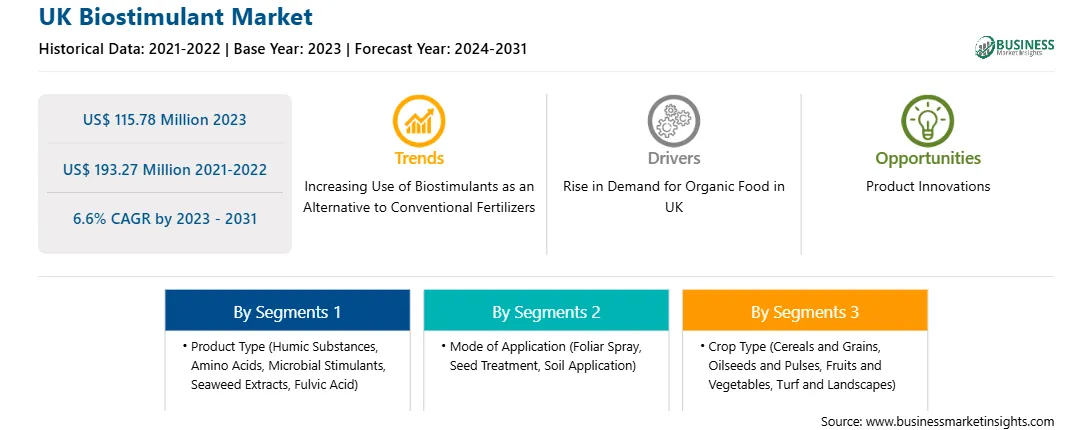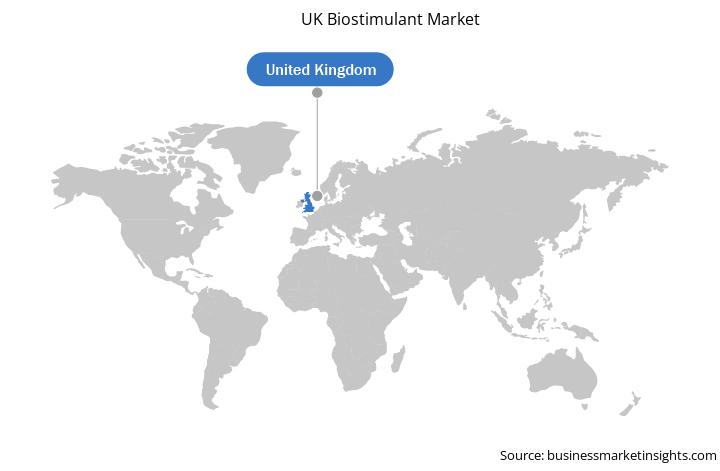The UK biostimulant market is expected to grow from US$ 115.78 million in 2023 and is projected to reach US$ 193.27 million by 2031; it is expected to register a CAGR of 6.6% from 2023 to 2031.
In the UK, biostimulants are used for soil conditioning in fertilizers as biostimulants enhance soil fertility and water-holding capacity. Biostimulants are sold in the country by online and offline distribution. The growth of online retail channels has made biostimulants readily available for cereals, grains, gardening, and landscaping applications. This is one of the most significant factors responsible for the country's biostimulant market growth. Farmers in the UK increasingly recognize the benefits of integrating biostimulants into their agricultural practices to improve soil health, increase crop yields, and mitigate climate change impacts. Government policies promoting sustainable agriculture, such as the Environmental Land Management Scheme, provide financial incentives for farmers to adopt biostimulants as soil amendments.
The UK's commitment to achieving net-zero emissions by 2050 has spurred investments in biostimulant production facilities and research into innovative biostimulant applications, further driving market expansion. Collaborations between academia, industry, and government agencies also foster innovation and knowledge exchange, positioning the UK as a hub for biostimulants research and development. The key market drivers include cost-effectiveness and easy availability. Further, biostimulants help maintain the soil's pH and acidity levels. The national government also encourages the application of biostimulants by spreading awareness and benefits among consumers. All these factors are likely to support the growth of the biostimulant market in the UK.
Consumers across the UK are increasingly interested in organic products, such as organic fruits, vegetables, and other organic food products. The demand for organic food is primarily due to the increase in the health-conscious population and a surge in awareness about the health risks of chemical fertilizers and plant growth promoters. Biostimulants have zero side effects on plants and human health. The changing preference of people for healthier food products is increasing the demand for organic products. This is encouraging farmers across the country to produce crops using organic methods. Additionally, using organic and bio-based compounds in agriculture and forestry offers a significant opportunity for farmers to improve root and shoot growth, better growth potential, and stress resistance. Biostimulants are substances or microorganisms applied to plants, soils, and seeds for enhancing crop yield, quality traits, plant tolerance to a wide range of biotic and abiotic stresses, and nutrient use efficiency. The growing preference for organic food has stimulated its production in the UK. According to data published by the UK government, three major crop types are grown organically: cereals, other arable crops, and vegetables (including potatoes). In England, the area of organically grown cereal crops increased by 1.2% to 43,000 hectares in 2023. Other arable crops increased by 7.1% to 9,300 hectares. Thus, the strong emphasis of the government and other stakeholders on the organic and sustainable mode of farming has increased the acceptance of biostimulants.
A few key players operating in the UK biostimulant market are EcoStim, Bioelements Ltd, Bionema, Russell IPM, Sipcam UK, IntraCrop, Syngenta AG, UPL Ltd, BIOSTIMULANTS LTD, Nichino Europe Co. Limited, and Central Pharma. Players operating in the market are highly focused on developing high-quality and innovative product offerings to fulfill customers' requirements.
The overall UK biostimulant market size has been derived using both primary and secondary sources. Exhaustive secondary research has been conducted using internal and external sources to obtain qualitative and quantitative information related to the market. Also, multiple primary interviews have been conducted with industry participants to validate the data and gain more analytical insights into the topic. The participants of this process include industry experts, such as VPs, business development managers, market intelligence managers, and national sales managers—along with external consultants, such as valuation experts, research analysts, and key opinion leaders—specializing in the UK biostimulant market.
Strategic insights for the UK Biostimulant provides data-driven analysis of the industry landscape, including current trends, key players, and regional nuances. These insights offer actionable recommendations, enabling readers to differentiate themselves from competitors by identifying untapped segments or developing unique value propositions. Leveraging data analytics, these insights help industry players anticipate the market shifts, whether investors, manufacturers, or other stakeholders. A future-oriented perspective is essential, helping stakeholders anticipate market shifts and position themselves for long-term success in this dynamic region. Ultimately, effective strategic insights empower readers to make informed decisions that drive profitability and achieve their business objectives within the market.

| Report Attribute | Details |
|---|---|
| Market size in 2023 | US$ 115.78 Million |
| Market Size by 2031 | US$ 193.27 Million |
| Global CAGR (2023 - 2031) | 6.6% |
| Historical Data | 2021-2022 |
| Forecast period | 2024-2031 |
| Segments Covered |
By Product Type
|
| Regions and Countries Covered | UK
|
| Market leaders and key company profiles |
The geographic scope of the UK Biostimulant refers to the specific areas in which a business operates and competes. Understanding local distinctions, such as diverse consumer preferences (e.g., demand for specific plug types or battery backup durations), varying economic conditions, and regulatory environments, is crucial for tailoring strategies to specific markets. Businesses can expand their reach by identifying underserved areas or adapting their offerings to meet local demands. A clear market focus allows for more effective resource allocation, targeted marketing campaigns, and better positioning against local competitors, ultimately driving growth in those targeted areas.

The UK Biostimulant Market is valued at US$ 115.78 Million in 2023, it is projected to reach US$ 193.27 Million by 2031.
As per our report UK Biostimulant Market, the market size is valued at US$ 115.78 Million in 2023, projecting it to reach US$ 193.27 Million by 2031. This translates to a CAGR of approximately 6.6% during the forecast period.
The UK Biostimulant Market report typically cover these key segments-
The historic period, base year, and forecast period can vary slightly depending on the specific market research report. However, for the UK Biostimulant Market report:
The UK Biostimulant Market is populated by several key players, each contributing to its growth and innovation. Some of the major players include:
The UK Biostimulant Market report is valuable for diverse stakeholders, including:
Essentially, anyone involved in or considering involvement in the UK Biostimulant Market value chain can benefit from the information contained in a comprehensive market report.